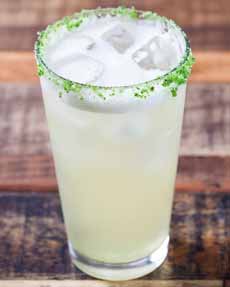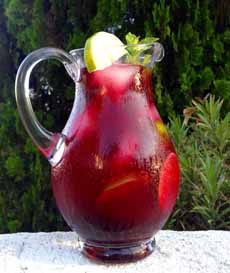TIP OF THE DAY: When Life Gives You Limes, Make Limeade
|
Summer is lemonade season. But what about limeade, it’s oft-ignored sister? You can easily make a quart of limeade with a can of frozen concentrate. Limeade is a refreshing base for a cocktail. Fill a rocks or highball glass with limeade and ice; then add gin, tequila or vodka to taste. While frozen concentrate is slightly easier, this limeade recipe can be made in 15 minutes. Give it a try: Friends and family will find it more special, since its so much more rarely served than lemonade. RECIPE: LIMEADE We adapted this recipe from one by Elise Bauer of Simply Recipes. Prep time is just 15 minutes, plus chilling (or if you can’t wait, add ice cubes). As with any cold drink, it’s easier to make simple syrup rather than trying to get straight sugar to completely dissolve. It takes only as much time as the water to boil. If for whatever reason you don’t want to make simple syrup, superfine sugar is a second choice. For a more exciting lime flavor, the simple syrup is infused with lime zest. Grate extra lime zest for a glass rimmer. The proportion of sugar is a guideline. You can use less if you like your drink less sweet. Also, limes can have different levels* of tartness. If you want to hedge your bets, use only 3/4 of the simple syrup, taste the finished limeade, and decide if you want to add the rest. Ingredients For 1 Quart 1. MAKE the simple syrup: In a small saucepan, combine the sugar, one cup of water and the lime zest, and bring to a boil. Stir to dissolve any remaining sugar granules, remove the pot from the heat and set aside to cool. 2. STRAIN out the lime zest: Place a strainer over a bowl or serving pitcher and pour the sugar syrup through it, straining out the zest. 3. ADD the lime juice and 2 cups of water and taste. If it’s too sweet, add a bit more lime juice. Add several sprigs of fresh mint. 4. CHILL or serve immediately over ice. Variations ________________ *Limes have a slightly higher acid content: On average, it’s about 6% for limes and 4.5% for lemons. Lemons have more fructose (fruit sugar): 2% for lemons, and between 0.5% and 0.75% for limes. Sugar has a suppressive effect on the perception of sourness, so lemon juice will appear to taste a bit less sour than lime juice. The composition of acids in the two also differ. The acid in lemon juice is almost entirely citric acid, which also makes up most of the acid in limes. However, limes include about 10% each of succinic acid and malic acid which have an effect on their flavor. Source: Craft Cocktails at Home by Kevin Liu. |
 [1] Mint is a delicious complement to limeade (photo Elise Bauer | Simply Recipes).
[4] Cucumber limeade: Just add sliced cucumbers. Here’s a recipe from Saveur. |
|
|
THE HISTORY OF LIMES It is believed that lemons derived from limes. In fact, if limes are left on the tree to fully ripen, they turn yellow and are indistinguishable from lemons. They’re harvested when green to prevent confusion at the market. Here’s a full lime history, the difference between Persian/Tahitian and Key/Mexican limes, and a photo glossary of the different types of limes the world over. Our favorite example: The blood lime of Australia is red inside and out!
|
||


